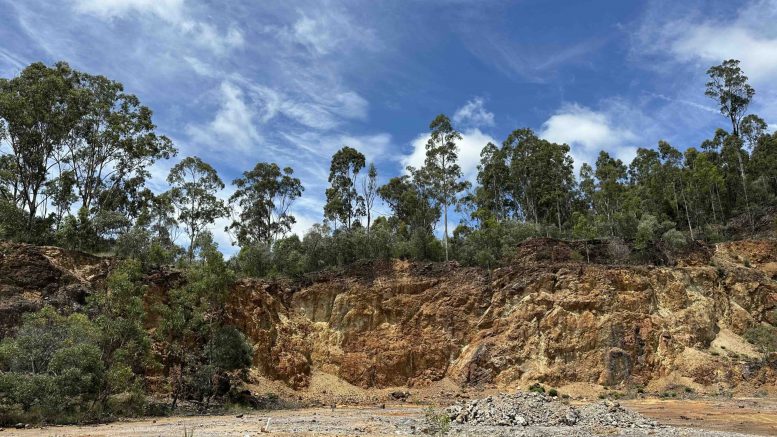Australian junior Legacy Minerals Holdings (ASX: LGM) is exploring a 170-year-old Drake mining district property that might see production and a multimillion-ounce discovery within a few years.
The Drake project is considered advanced with an estimated A$50 million ($32 million) spent on exploration and A$30 million on infrastructure by companies such as Newmont (TSX: NGT; NYSE: NEM) and Rio Tinto’s (NYSE, LSE, RIO, ASX: RIO) Kennecott and CRA, and a series of juniors. The project has a historical resource estimate of 688,000 gold-equivalent oz. that Legacy is updating to JORC standards.
“We’re here because we think that we can turn a 600,000-oz. gold deposit into something that’s multiples of that,” technical director Thomas Wall said during a February site visit. “We’re not looking for something small. We’re looking for something that’s substantial in size.”
What crews have found on the 160-sq.-km site are hundreds of mine shafts dating as far back as 1853. More recent drilling has shown assays such as 118 metres grading 1.71 grams gold per tonne, 6.9 grams silver and 1.12% zinc from 2 metres depth. A former owner planned but didn’t execute 33,000 oz. gold-per-year-output less than a decade ago.
Drake is one of nine Legacy projects in New South Wales, including Bauloora, a A$15-million (US$9.6-million) joint venture with Newmont. The JV is one of only two deals Newmont has done in Australia in the past three years – the other being the US$17-billion takeover of Newcrest Mining in late 2023. Legacy bought Drake for A$200,000 in mid-2023, only a few months after signing the Bauloora deal.
Hotspot state
NSW is home to Australia’s largest gold mine, Newmont’s Cadia, and a state where most of the world’s biggest miners are exploring for gold and copper.
“New South Wales is a new global hotspot for mining investment and exploration activity, and a fantastic place for us to be working,” Legacy managing director Christopher Byrne said during the site visit.
In December, Legacy reported that a light detection and ranging survey identified 391 mine shafts, 250 adits and 2,726 trenches and prospecting pits across the Drake project for a total of 3,367 historical mining features, more than double what was previously known.
“It’s exciting because it presents huge areas of opportunity,” Wall said.
“These are surface expressions of mineralization, so while it doesn’t say it’s going to be the next bestthing, it provides us with the locale to start our work.”
Systematic exploration
The project, one of the largest mineral systems in New South Wales, caused excitement when it excelled in a metric used to identify areas that have the possibility of hosting major deposits, Wall said. The number of 100 gram-metre gold-equivalent hits across the project was estimated to be around 100.
Other previous assays from the project include 12.8 metres at 48 grams gold and 2,589 grams silver from 16 metres depth; 143 metres at 1.1 grams gold, 3 grams silver and 0.9% lead and zinc from surface; 16 metres at 5.8% copper from 58 metres; and 10.1 metres at 7.26% copper from 88 metres.
Remarkably, the high-grade copper hits have never been followed up.
“One of the beautiful things that we’ve been able to get from the previous work is just a huge amount of data,” Wall said. “It’s taken us a long time, often to the frustration of people that follow the company of how long it’s taken us to get through it, but it requires that, because otherwise we’ll be putting out stuff that’s half-baked.”
Roughly 95% of the previous drilling on the project is less than 100 metres depth, with an average depth of just 49 metres.
“One of the big opportunities that we can deploy here is blowing those resources out at depth in areas where there’s known mineralization,” Wall said.
Legacy says Drake could host a system akin to Barrick Gold’s (TSX: ABX; NYSE: GOLD) Porgera gold mine in Papua New Guinea, which has an endowment of around 19.7 million gold-equivalent oz., and K92 Mining’s (TSX: K92) Kainantu operation in the same country.
Legacy is undertaking an airborne magneto telluric survey over Drake, the same survey that led to the multimillion-ounce Kora and Judd discoveries at Kainantu.
Production path
A previous Drake owner completed a prefeasibility study (PFS) in 2015 using just 23% of the historical resource. Based on a gold price of A$3,000 per oz., the study generated a net present value of A$185 million and internal rate of return of 153%.
Legacy has updated the PFS which Byrne said would still be conservative, using a gold price of around A$3,500 per oz. compared with the current price of more than A$4,600 per ounce. He estimates the capital costs would have risen by roughly 35% and believes all-in sustaining costs of A$1,700 per oz. are possible due to the low strip ratio.
“We’re also conscious that with the exploration upside here, we’re looking for a bigger system outside a relatively small operation in the scheme of things, and that’s why we first came to Drake.
“We pretty much inherited a development project, if we’d like to go down that pathway, but we certainly still have got that big picture in mind.”


Be the first to comment on "Site visit: Legacy probes past for next big find"